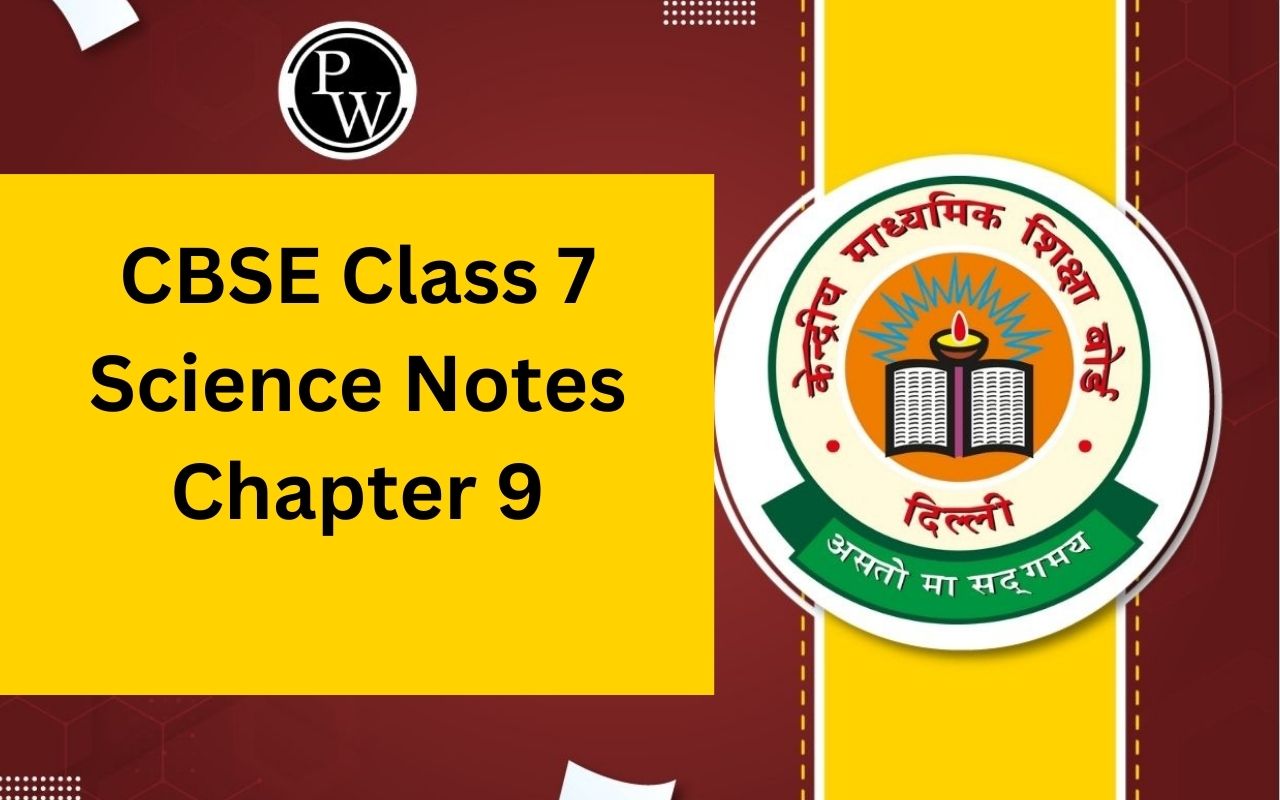

CBSE Class 7 Science Notes Chapter 9: The online notes for Class 7 Science Chapter 9 are current with the syllabus and can be accessed here. The purpose of these review notes is to assist students in getting ready for their exams. They will introduce the students to the fundamental ideas covered in Chapter 9, "Soil," and get them ready for more advanced coursework that will require them to comprehend more specialized information.
In Class 7 Science, Chapter 9, "Soil," the definition of soil and its formation process are covered in detail. Students must comprehend this foundational chapter thoroughly before moving on to more complex plant-related subjects. By providing a summary of the important subtopics, the Class 7 Soil Chapter notes will help students understand the contents of this chapter. These notes have been prepared by our specialists to assist students in grasping the material and improving their exam scores.CBSE Class 7 Science Notes Chapter 9 Overview
These review notes provide a synopsis of the chapter and emphasize the most important details under each subsection. Each topic and area has been addressed by the experts in a separate paragraph along with a point-by-point description. Let me summarise the notes for Class 7 Science, Chapter 9, Soil. The definition of soil and its significance are explained in these review notes. Comprising of humus and rock fragments, soil is the topmost layer of the earth's crust. The process of soil formation, which involves the parent rock's dissolution, is further explained in these notes. The components of soil and the soil profile are also explained in the notes for Soil Class 7. Both live and non-living materials make up the soil, which is divided into several categories. Students can study the various types of soils, their properties, and their applications by going through these clear and concise review notes. It would assist students in responding to any exam questions about this chapter.CBSE Class 7 Science Notes Chapter 9 PDF
Here we have provided CBSE Class 7 Science Notes Chapter 9 for the ease of students so that they can just download the pdf and use it easily without the internet. These CBSE Class 7 Science Notes Chapter 9 will help students understand the chapter better.CBSE Class 7 Science Notes Chapter 9 PDF
CBSE Class 7 Science Notes Chapter 9
Below we have provided CBSE Class 7 Science Notes Chapter 9 for the ease of students so that they can prepare better for their exams.Soil
The majority of the land is covered in soil, which is the loose substance that sits on top of Earth's crust. It is made up of both organic and inorganic materials and is crucial to the survival of life on Earth because it gives vegetation structural and nutritional support. Depending on the place in which it is located, soil can have very different chemical and physical characteristics.Soil Formation
The breakdown of rocks as a result of weathering and natural erosion processes creates soil. The characteristics of soil are determined by the weathering conditions. Here are some of the primary procedures: Physical weathering is the result of physical forces such as the sun, wind, ice, etc. that alter the volume of rocks, causing them to dissolve. These agents can also alter the temperature or pressure. Chemical weathering is the process by which various chemical substances, such as rainwater, react with the minerals found in rocks to create new salts or minerals. Living things like plants, animals, and other microbes carry out the process of "biological weathering" by secreting or releasing acids that break down the rocks.Humus
The organic component of the soil that is created when plant matter is broken down by soil-dwelling microbes is called humus. The decomposing dead matter in the soil is called humus.Weathering
The breakdown or dissolution of rocks and minerals on the surface of the Earth is known as weathering. Weathering agents include water, ice, acids, salt, plants, animals, and temperature fluctuations.Horizon
Each layer in a soil profile is defined as a horizon . 1. A- horizon or topsoil is a soft, porous layer that can absorb and hold more water. 2. B-horizon, or middle layer, is the more compact and harder layer. 3. C-horizon is the third layer made up of small rocks. 4. Bedrock is the fourth and hardest layer.Soil Profile
The soil profile is the vertical portion of soil that is located above the underlying rocks and has different layers that are identified by their characteristics and grain size, or soil horizons. The following are the primary layers present in all soil profiles:-
Humus or organic matters
-
Topsoil
-
Subsoil
-
Parent material
-
Bedrock
Types of Soil
There are mainly three types of soil;
1. Sandy Soil: This type of soil lacks nutrients and is typically warm, dry, and acidic. Their diameter ranges from 0.2 mm to 2.0 mm. Because they have more sand than clay, which weighs heavier, they are often referred to as light soils. Rain merely washes the nutrients away from them because they are very easy to deal with and have faster water drainage. Nevertheless, adding more organic materials can stimulate plant growth.
2. Clayey Soil: This type of soil is dense and nutrient-rich. In winter, they remain chilly and wet, while in summer, they become dry. This soil contains more than 25 percent clay, and the voids between the particles retain a lot of water. Because of this, in the heat, the water drains slowly and frequently takes longer to warm.
3. Loamy Soil: This soil helps to reduce the harmful impacts of both sand and clay by combining the two. Water drainage can be regulated based on the ratio of clay to sand. Most gardeners choose this sort of soil because it is easier to work with.
Uses of Soil
The various properties of soil and their richness with nutrients, minerals, water, and microorganisms make them useful in many fields.
Agriculture: Soil helps plants retain water and nutrients, but it also gives their roots the air, water, and other elements they need to grow and yield. Building: Red bricks, which are used in construction procedures, are mostly made from soil. Compacted soil has a higher density, which enhances its ability to support loads. Pottery: To manufacture ceramics or pottery, clay soil is combined with water. It is allowed to dry after shaping to maintain its shape. Pottery includes items like bowls, vases, cups, sculptures, and more. Medicine and cosmetics: Some of the microorganisms in soil aid in the defense against pathogenic pathogens. Numerous skin ointments, antitumor medications, and tuberculosis medications are prepared with it.Percolation Rate
Percolation
The process of filtering liquid as it goes through a filter is called percolation. Rainfall enters the earth by a process called percolation, in which water seeps through the microscopic openings between rocks and soil particles. Like water filling a sponge's microscopic holes, the water gradually saturates the underlying rock. This contributes to the replenishment of underground aquifers.Percolation Rate of soil
The soil's absorption rate is ascertained by measuring its percolation rate. The ratio of the water volume in millimeters to the percolation duration in minutes is known as the percolation rate. Water volume (mL) divided by percolation time (min) equals percolation rate (mL/min).Moisture and Absorption
Moisture in Soil
- Moisture in soil is the amount of water present in the soil.
- Moisture in the soil can be removed by setting up the following experiment.
Absorption of Water by Soil
The amount of water absorbed by the soil when water is poured into the soil is called absorption capacity or absorption of water by soil.Crops
Crops and their Relation to Types of Soil
Different crops are grown in different places based on soil composition and climate conditions.- Loamy and clayey soils are suitable for cultivating cereals like wheat and gram.
- Clayey soils, soils high in organic matter, and soils with a high water-retention capacity are ideal for producing wheat and paddy.
- Loamy soils are excellent for growing cotton, lentils (masoor), and other pulses because they have a high drainage capacity and can retain large amounts of water.
Hydroponic plants
Plants do not need soil to grow instead, these plants need water to grow. These types of plants are known as hydroponic plants.
Benefits of CBSE Class 7 Science Notes Chapter 9
- The greatest resources for comprehending and practicing the material are our Revision Notes for Class 7 Chapter 9 Soil.
- Every element and point are covered in detail in the material.
- The simplest solution for each situation in the material provides a clear explanation of the word.
- The primary themes are covered in our Revision Notes for Class 7 Chapter 9 - Soil, allowing students to concentrate and become ready for the test.
CBSE Class 7 Science Notes Chapter 9 FAQs
What are the important points of soil Class 7?
Why is soil important to Class 7?
What are the important notes on soil?











